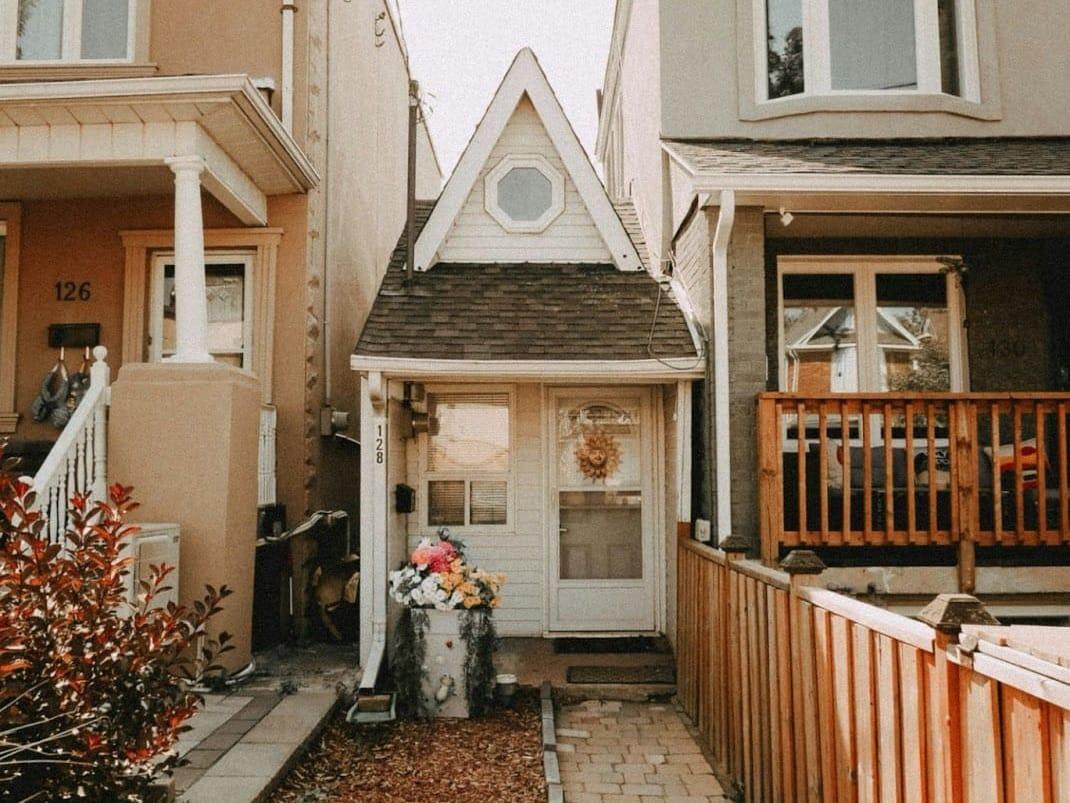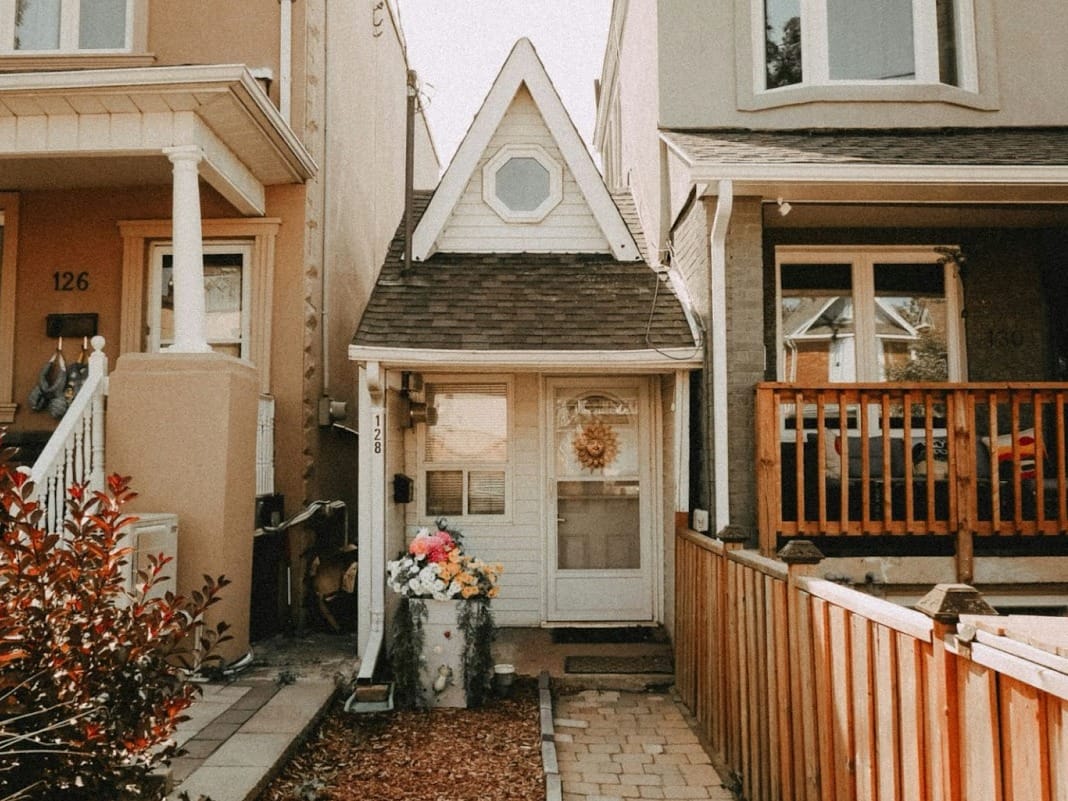Home Design Ideas: 42 Tips to Love Your [Small] Space
This blog offers tips for decorating small spaces, focusing on maximizing functionality and style with smart furniture choices and effective storage solutions.

Small spaces can contain multitudes, just like you.
Turning your house into a home is about more than shopping for furniture you love or finding the best prices on those pieces. Finding the best prices can keep you awake at night—probably scrolling on your phone to find the best deals online.
Determining how to design a small house or apartment can consume your thoughts. You want your home to feel cozy, but wouldn't it be great if you could figure out how to make a small space seem bigger? You want to choose the perfect color palette and furniture arrangement. What if you could turn your tiniest space into your favorite, most aesthetic room?
In this article, you will find our favorite small entryway design ideas, small living room ideas, modern office design ideas for small spaces, and more. Ultimately, you are the best interior designer for your home. You know what makes you happy, so follow these tips to find the best hacks and home design ideas for decorating your small space and appreciating the warmth and connection you create there.

Small Entryway Design Ideas
The best small entryway design ideas represent your style sense and what you value most. They also invite your family, friends, and even strangers into the comfort of your cozy home. Combine these small entryway design ideas with the personal touches that will bring you joy and make the ones you love feel they have found a home away from home.
- Light up the entryway. Brightening the entryway will make it appear more spacious. Pendants and hanging lamps may be overwhelming, so we recommend semi-flush mount light fixtures or recessed lighting to save space and create a warm, welcoming ambiance proportional to the space.
- Use mirrors to create the illusion of more space. Mirrors are one of the best tricks for making a small space seem bigger. In an entryway, you can position a mirror to reflect light from windows or entry doors into darker corners of the room. Frameless mirrors offer a modern touch for an aesthetic room.
- Create an accent wall. Wallpaper, paint colors, and decals, oh my! There are so many options for bold colors, funky patterns, and wall decals or murals that draw attention to one wall in your entryway. A deep blue, green, or grey can add a dramatic touch; Benjamin Moore's 2024 Color of the Year is Blue Nova, a captivating blue-violet shade. Or add a fun geometric or floral statement using removable wallpaper, decals, or murals.
- Add a rug to make the entryway cozy. Choose a small square or rectangular rug sized to leave plenty of room for pathways or door swings. We recommend an easy-to-clean, flatwoven area rug that complements the color scheme.
- Multi-functional furniture for the win. Small entryway design ideas must include multi-functional furniture to save space. Storage benches, console tables, and wall-mounted coat racks are popular choices. They make space for your shoes, bags, and coats—somewhere other than the floor! Floating shelves are a perfect place for keys and meaningful framed photos.
- Keep it clutter-free! Regularly donate or discard items that you aren't using anymore. Remember: one of the joys of a small entryway (and home) is keeping what continues to bring you joy. Marie Kondo was onto something here!
Open Concept Living Area Design for Small Spaces
Your living, kitchen, and dining spaces may be combined, especially if you live in a studio-style apartment, loft, or renovated home. Townhouses, modern condominiums, tiny houses, and even newly built homes can all have open-concept living areas. If you have a space like this, you know the joys and challenges it can bring. Consider these tips when designing a small open-concept living space.
- Shop for multi-functional furniture. To make the most of a small open-concept living space, consider saving space with a sofa bed, nesting tables, or a storage ottoman. TV trays, extendable dining tables, and folding tables and chairs can make your life easier.
- Arrange your furniture strategically. In an open-style living area, you get to decide where your living room ends and your dining room begins. You can do so by using rugs and strategically placing your furniture to define areas within the space for various activities.
- Choose items that fit well in the space. Oversized furniture quickly takes up space, but proportional furniture is your friend! Sleek, streamlined furniture can ensure plenty of room for lounging, dining, cooking—and walking, which is equally important.
- Embrace glass and transparent materials. Glass shelving, flooring, and accents are visually interesting and can catch & reflect light while also allowing it to pass through. Mirrored or reflective surfaces also bounce light around in an open-concept space, making them a perfect addition to a small apartment or open living area.
- Keep the floor clear. When designing your small apartment layout, use floating or wall-mounted shelving and hooks for hanging jackets, backpacks, etc. A clean floor makes your space look neat and a bit more spacious. Win-win!
- Follow the "one in, one out" rule. Consider only allowing yourself to bring something new into the space if you’re willing to part with something else. Doing so will minimize clutter—which inevitably piles up even faster in a small space—and make you feel more mindful as a consumer.
Bedroom Designs for Small Spaces
Your bedroom should feel comfortable, functional, and aesthetic. You don't have to have the biggest bedroom to make it cozy and inviting at the end of a long day. If you're wondering how to design or arrange your small bedroom, these ideas can help you create a bedroom you love.
- Choose the right size bed. Decide which bed size will be appropriate for your space. For example, a full-sized bed will fit best in a 10x10 bedroom; a Queen-Sized bed could fit in a 10x11 bedroom, and a King or California King bed would fit best in a room that is at least 12x12.
- Incorporate a soothing color palette. Soft neutrals and calming blues can make your bedroom feel calming and inviting. Dark colors can make the room feel smaller, but lighter, brighter colors appear to create more space. The color palette you choose reflects your personal expression and enhances the aesthetic appeal of your bedroom.
- Keep it organized. Baskets, bins, and under-bed storage can keep clothing, shoes, and other belongings out of sight. A tidy space reduces stress levels, improves focus, increases efficiency, and just feels nice. Organizing might do the trick if you're wondering how to make your bedroom feel lighter and calmer.
- Create a focal point. A statement headboard, large artwork above the bed, a chandelier, an accent wall, and decorative shelving are excellent examples of bedroom focal points. The primary purpose of a focal point is to anchor the room's design and make it feel like your favorite, most aesthetic room.
- Add a gentle glow. Soft bedside lamps or string lights can create a gentle glow that provides a calming effect, promotes sleep, and creates a romantic ambiance. Dimming switches and adjustable lamps allow you to adjust the lighting as necessary.
- Opt for wall-mounted furniture. Wall-mounted bedside tables, desks, and shelves can provide storage or display space without cluttering the floor.
Living Room Design for Small Space
You may have an awkward living room layout, a tiny floor space, or limited natural light. These can all prove to be not-so-tiny challenges when designing your living room, but it's your lucky day—we're full of small living room ideas.
- Choose smaller-scaled furniture. Small-scale couches, armchairs, or recliners are all excellent choices for small living spaces. Slim-profile and multi-functional furniture will help you make the most of every square inch of your living room. Pieces with exposed legs allow light to flow underneath. A lift top coffee table can provide extra storage or work space.
- Utilize vertical space and storage. Tall bookcases, cabinets, and armoires can help reduce clutter and maintain a clean appearance while also providing concealed storage for electronics, board games, books and notebooks, jackets, and all the other things that tend to pile up in a small space.
- Divide the living space into zones. A key idea of living room design for small space is to divide the area into 'zones.' What does that mean? So, in a small apartment or home without clear boundaries between living and dining, create sections using area rugs or furniture groupings. Creating zones helps distinguish between your reading nook, home office, dining table, and play area.
- Choose light-colored paint. Lighter wall, ceiling, and floor colors reflect more natural light and create an open, airy feeling. Painting walls and ceilings the same color will make the room look (and feel) taller.
- Find the most efficient layout. Arrange furniture to create clear pathways and maximum usable space. Move around your coffee table, sofa, chairs, and rugs to find what works best for your space.
- Try a monochromatic color scheme. A monochromatic color scheme creates visual continuity. Too many colors can actually make the room feel smaller, but a monochromatic scheme ties everything together. (I've done this in my living room using light blue for the curtains, bookshelf, accent rug, and even a few hand-painted art pieces.)
Kitchen Designs for Small Space
A kitchen doesn't need to be gigantic to be functional, aesthetic, and enjoyable. We've shared before about what makes a home special, and even the smallest kitchens can nourish the soul—and a family's hungry bellies.
- Compact appliances are a must-have! To maximize counter space, choose compact appliances. Even a few appliances can fill your kitchen quickly!
- Reflective surfaces can maximize space. Reflective surfaces include glass tile backsplash or polished countertops—think granite, marble, or quartz! High-gloss flooring, such as polished tile, hardwood, or laminate, can create the illusion of space while enhancing your kitchen's contemporary elegance.
- Choose open kitchen designs for small space. Kitchenettes, galley kitchens, and one-wall kitchens are common in smaller homes and studio apartments; cohesive color schemes, built-in storage, and reduced clutter will all help make any kitchen feel roomier.
- Maximize counter space & storage space. Floating shelves and freestanding cabinets can offer additional storage in the best small-space kitchen designs; hidden storage items, such as pull-out pantry shelves or lazy Susans, can help maximize your limited space.
- Ensure easy traffic flow and avoid creating bottlenecks. Make it easy for yourself (and others) to move around your kitchen. A sign in my kitchen reminds me of my grandma every day: "I love hugs, I love kisses, but what I love is help with the dishes." If you make it easy for people to move around your kitchen, they won't mind washing and drying dishes. Win-win!
- Keep experimenting until you find what works. Decorating is sometimes finished but never done. It’s okay to make changes until you find what works best in your small kitchen space.
Bathroom Designs for Small Spaces
Believe it or not, bathrooms in small spaces are—you guessed it, smaller than other bathrooms. How can you make the most of your tiny bathroom space? Try incorporating these ideas into your bathroom designs for small spaces.
- Mirrors! A large mirror above the sink or an entire mirrored wall can add dimension. Pinterest has a ton of cool ideas if you need some inspiration for simple bathroom designs for small spaces.
- Consider a floating vanity. How do you make your smallest room look bigger using furniture? A wall-mounted vanity can be installed onto the wall rather than resting on legs or a base. The sink’s plumbing is hidden within the wall.
- Glass shower doors. Glass doors allow light to pass through the entire bathroom. Frosted doors can help you maintain privacy while maximizing brightness.
- Save door & hall space with a pocket door. Since a pocket door slides into the wall, you have more space to display decor, place a throw rug you love, or focus on other special touches.
- Use layered lighting. Combine task, ambient, and accent lighting for an inviting and functional space. LED lighting is popular for lighting a mirror or underneath your favorite floating vanity.
- Add aesthetic touches. A well-designed bathroom can be a lovely aesthetic room. You can add touches that make it a stylish retreat; personalizing your bathroom can make it a functional and comfortable place to relax and rejuvenate.
Modern Office Design Ideas for Small Spaces
Having a small space doesn't mean you have to sacrifice your home office! Remote workers, freelancers, entrepreneurs, creators, researchers, and students—for so many of us, work has become one of the activities of our homes. These modern office design ideas for small spaces can help you create a workspace you feel proud of.
- Utilize space in another room. You may have already noticed, but you'll likely need to fashion your home office out of the corner of your dining room or bedroom.
- Consider your lighting carefully. More natural light means less of a need for artificial lighting. Lamps can take up space, although sometimes they are necessary. Track lighting, LED lights, and adjustable desk lamps can all help if you need more.
- Minimize distractions. IYKYK. Distractions can be one of the most significant challenges of a home office and a small space in general. A room divider, noise-canceling headphones or earplugs, and creating a plan with other family members can help!
- Inspire creativity. Fortunately, a modern office design for small spaces still requires decorating, and choosing decor you love can inspire creativity, motivation, and peace while you're working. Get creative when choosing decor that matches your vibe.
- Keep it minimalist—or maximalist. Really, who are we to tell you? Modern office design ideas for small spaces include a minimalist space, sleek lines, simple shapes, and a neutral color palette. Some people think less is more, and others embrace modern maximalism instead. What really matters is creating a workspace that inspires you.
- Make your furniture count. From wall-mount desks to ergonomic chairs, there are ways to make every furniture choice count in a home office. Whether for comfort or functionality, the furniture you choose makes a huge difference in your home office.
Simple home ideas for small spaces can make a huge difference. We love exploring new ways to make the most of our spaces. More importantly, we want you to feel empowered to decorate, maximize, and love your small space.
We would love to hear (and see!) what works best in your small spaces. Send us a photo of your space and your favorite design tips to be featured in an upcoming post.
Jen Buckner
Writer at Spoken
Jen is a furniture content aficionado at Spoken. She is a Delaware native living on Tulsa time with her husband Blake and three super-cool kids. Jen enjoys using her words to inspire people to make the world—and their worlds—better. When she's not writing, she's driving her kids around, picking out something cute to wear, or volunteering for a local nonprofit. Oh! And she'd always rather be at the beach (with a bucket of fries).
Read more

